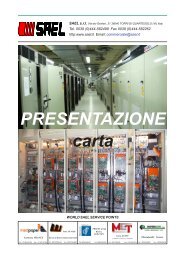USER`S GUIDE High Speed DC Circuit Breaker TYPE ... - Biziz
USER`S GUIDE High Speed DC Circuit Breaker TYPE ... - Biziz
USER`S GUIDE High Speed DC Circuit Breaker TYPE ... - Biziz
Create successful ePaper yourself
Turn your PDF publications into a flip-book with our unique Google optimized e-Paper software.
2.4 Operation<br />
3. Inspection and Maintenance<br />
Maximum operating voltage and current ratings are<br />
as shown on the breaker nameplate.<br />
During continuous operation, it must be loaded with<br />
its rated operating current at maximum. Load currents<br />
in excess of breaker nameplate rating are allowable<br />
for brief periods. Refer to the short time currents<br />
listed in Table 1a/1b. Do not exceed the rated<br />
operating voltage shown on the breaker nameplate.<br />
The drive and auxiliary trips function within the<br />
specified control voltage range. The auxiliary trips<br />
must be loaded with the values listed in Table 2a at<br />
maximum.<br />
Prior to carrying out maintenance, inspection or<br />
checks on the circuit breaker, the breaker must<br />
be open, the connections on both sides must be<br />
grounded, the circuit breaker must be switched<br />
off and the control plugs removed.<br />
Non-compliance with these warnings can result<br />
in death, severe physical damage and extensive<br />
damage to equipment.<br />
Metric tools are needed for all screws.<br />
3.1 General<br />
Regular inspection and maintenance must be carried<br />
out to ensure the proper functioning of the<br />
breaker and in order to achieve a long working life.<br />
The intervals at which inspections must be carried<br />
out may be determined by evaluating the breaker’s<br />
duty cycle. Table 3a provides an overview of checks<br />
to be carried out and lists the appropriate inspection<br />
intervals. Table 3b provides indicators for maintenance<br />
work. In order to check the latch mechanism,<br />
the breaker can be opened and closed with a hand<br />
lever. Fig. 2 shows the correct use of the lever.<br />
Fig.1 Setting the overload release<br />
Fig. 2 Manual ON/OFF.<br />
10

















